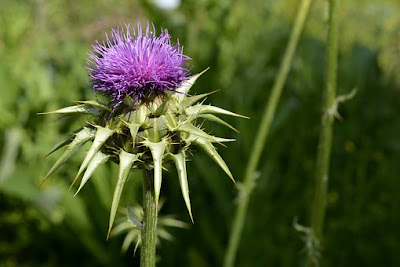
Scientific name: Fucus vesiculosus
Common names: Bladder Fucus, Brown seaweed, Black-Tang, Cutweed, Sea-Wrack, Brown Algae, Kelp-Ware.
Description:
Brown seaweed or brown algae also known as bladderwrack got it's name because of the bladder-like feature or sac
on either side of the midrib that keeps them afloat. The frond is fan-shaped, narrow, wavy and divided into two with a broad midrib running to the apex. The color is brownish green to yellow. It grows on the Atlantic coasts of Europe and North America and Baltic Sea. It is attached to the rocks found underneath the water. Its root-like
branch attaches itself to the rocks and it grows up to about 3 feet high. The bladderwrack is used as a herbal medicine and the entire plant is harvested while still small.
Bladderwrack can be eaten raw or cooked, boiled or steamed.
Parts used: Whole plant, dried stem, leaves and root.
Medicinal properties and Health benefits of Bladderwack:
Bladderwrack contains 3 main components namely:
Iodine -The body needs iodine but cannot make it. The thyroid gland needs iodine to make hormones. Lack of iodine
can cause an enlarged thyroid gland (goiter)/hypothyroidism. It regulates thyroid function and metabolism.
Alginic acid - is a type of dietary fiber that helps alleviate constipation, diarrhea, GERD and heartburn.
Fucoidan - a type of dietary fiber that helps lower cholesterol(heart condition) and glucose level (diabetes). It also has anti-inflammatory effect, anti-coagulant (blood-thinning) properties and inhibit cancer growth.
 Bladderwrack also contains mannitol, bromine, zeaxantin, algin, polyphenols, proteins, oleic acid, essential fatty acids and fiber. It is also rich in vitamins like vitamin C, B-vitamins, beta-carotene and has many minerals like sodium, sulfur, magnesium, zinc, iron, and potassium.
Bladderwrack also contains mannitol, bromine, zeaxantin, algin, polyphenols, proteins, oleic acid, essential fatty acids and fiber. It is also rich in vitamins like vitamin C, B-vitamins, beta-carotene and has many minerals like sodium, sulfur, magnesium, zinc, iron, and potassium.Skin Care/Smoother Skin
Bladderwrack in powder form can be added in bath water or facial scrub to smoothen and nourish the skin. It also relieves the eczema and psoriasis.
Rheumatoid Arthritis
Bladderwrack can also be brewed or steeped in a quart of hot water and taken internally or applied to the skin to help relieve the symptoms of rheumatoid arthritis.
Precautions:
Bladderwrack is generally safe and considered a safe herb supplement to use. However, if supplements can interact with other drugs and it's still best to consult a doctor when taking this as a supplement.



